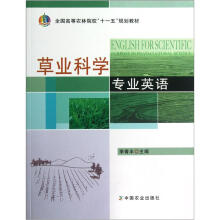前言
Lesson 1 Plants and Their Lives
Part A The Parts of a Plant and Their Functior
Part B Reading Exercise:The Life Cycle of a Plant
Part C Glossary and Word Building
Lesson 2 Types of Plants and Variety of Life
Part A Types of Plants
Part B Reading Exercise:The Variety of Life
Part C Glossary and Word Building
Lesson 3 The Biodiverity
Part A Agrobiodive ityThe Value of Diverity and Wildness
Part B Reading Exercise.The Diverity of Life
Part C Glossary and Word Building
Lesson 4 Ecology--Living Organisms and Their Environment
Part A The Ecosystem
Part B Reading Exercise:Scientific Method
Part C Glossary and Word Building
Lesson 5 Land Resources
Part A Types of Rangeland
Part B Reading Books (1):Book Contents
Part C Reading Exercise:Follow Irtructior
Lesson 6 Animal Production on Pastures
Part A Methods of Grazing
Part B Reading Books (2):Preface and Introduction
Part C Writing.Resume (Curriculum Vitae,CV)
Lesson 7 Germplasm Exploration for Wild Species
Part A Plant Resource Evaluation
Part B Reading Books (3)..The Main Text
Part C Reading I tructior:How to Conduct an Experiment
Lesson 8 Grazing Management
Part A Stocking Rate and Grazing Management
Part B Reading Journal Articles (1):Sectioning in Academic Paper
Part C Writing:Covering/Application Letter
Lesson 9 Forage Production
Part A Forage Establishment
Part B Reading Journal Articles (2):The Introduction Part
Part C Glossary and Word Building
Lesson 10 Forage Utilization
Part A Alfalfa Forage and Hay
Part B Reading Journal Articles (3):Materials and Methods
Part C Glossary and Word Building
Lesson 11 Forage Procession and Corervation
Part A The Corervation of Grass
Part B Reading Journal Articles (4):Results (and Analysis)
Lesson 12 Grasses for Amenity
Part A The Turfgrass Industry
Part B Reading Journal Articles (5):Discussion and Conclusion
Part C Choice of Tere in Academic Pape
Lesson 13 Lawn Establishment
Part A Nine Steps for Establishing a New Lawn Using Sod
Part B Reading Journal Articles (6):Acknowledgment and References
Lesson 14 Nutrition for Grazing Animals
Part A Meeting the Nutritional Needs of Ruminants on Pasture
Part B Reading Skill
Lesson 15 Scientific Writing
Part A Writing Academic Paper
Part B Writing Abstracts (Synopsis,Summary)
Part C Example of Abstract Writing
Part D I truction for Preparation of Poster
Keys to Exercises

